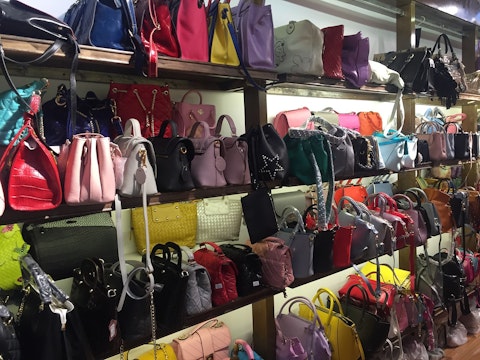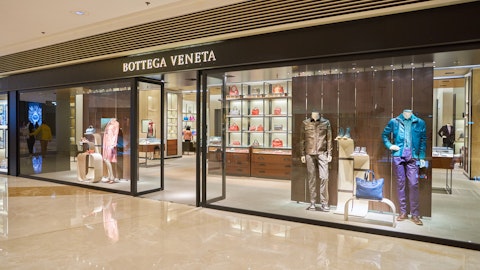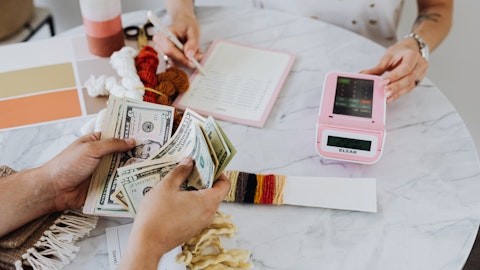Tapestry, Inc. (NYSE:TPR) Q4 2023 Earnings Call Transcript August 17, 2023
Tapestry, Inc. misses on earnings expectations. Reported EPS is $0.95 EPS, expectations were $0.96.
Operator: Good day, and welcome to this Tapestry conference call. Today’s call is being recorded. Later, you will have the opportunity to ask questions during the question-and-answer session. [Operator Instructions] At this time, for opening remarks and introductions, I would like to turn the call over to the Global Head of Investor Relations, Christina Colone.
Christina Colone: Good morning. Thank you for joining us. With me today to discuss our fourth quarter and year-end results, as well as our strategies and outlook are Joanne Crevoiserat, Tapestry’s Chief Executive Officer; and Scott Roe, Tapestry’s Chief Financial Officer and Chief Operating Officer. Before we begin, we must point out that this conference call will involve certain forward-looking statements within the meaning of the Private Securities Litigation Reform Act. This includes projections for our business in the current or future quarters or fiscal years. Forward-looking statements are not guarantees, and our actual results may differ materially from those expressed or implied in the forward-looking statements. Please refer to our annual report on Form 10-K, the press release we issued this morning and our other filings with the Securities and Exchange Commission for a complete list of risks and other important factors that could impact our future results and performance.

Non-GAAP financial measures are included in our comments today and in our presentation slides. For a full reconciliation to corresponding GAAP financial information, please visit our website, www.tapestry.com/investors and then view the earnings release and the presentation posted today. Now let me outline the speakers and topics for this conference call. Joanne will begin with highlights for Tapestry and our brands. Scott will continue with our financial results, capital allocation priorities and our outlook going forward. Following that, we will hold a Q&A session where we will be joined by Todd Kahn, CEO and Brand President of Coach. After Q&A, Joanne will conclude with brief closing remarks. I’d now like to turn it over to Joanne Crevoiserat, Tapestry’s CEO.
Joanne Crevoiserat: Good morning. Thank you, Christina, and welcome, everyone. As noted in our press release, we achieved record EPS this fiscal year, reinforcing the power of brand building, consumer-centric strategies and disciplined execution. Importantly, we meaningfully advanced our strategic priorities, engaging with consumers around the world through product excellence, unique storytelling and distinctive omnichannel experiences. At the same time, we continue to invest in our brands and our data-rich consumer engagement platform, which underpin our growth agenda. I want to thank our talented global teams for continuing to drive our strong results. Touching on the strategic and financial highlights for the year. First, we powered global growth achieving 3% constant currency revenue gains consistent with our outlook and underscoring the benefits of our globally diversified business model.
These top line results were led by our international businesses, which grew 13% excluding FX. This included a 5% increase in Greater China despite facing incremental COVID-related pressures in the first half of the year. Importantly, our business in China rebounded in the second half achieving 50% growth in the fourth quarter supported by a strong improvement in traffic and representing an increase compared to the region’s peak fiscal ’21 levels. Our international results were also fueled by strong momentum in Other Asia with sales growth of 36% as well as in Japan, where revenue rose 15%. In Europe, sales increased 7% for the year. In North America, sales for the year declined low-single digits against a challenging consumer backdrop. In the fourth quarter, our business decreased 8% versus last year, though, we delivered significant gross margin improvement and handbag AUR growth, consistent with our commitments to prioritize long-term brand health.
Importantly, our business in North America has improved meaningfully on a sequential basis quarter-to-date in Q1 with revenue trending in line with prior year on continued higher margins as we began to anniversary easier comparisons. Second, we continue to focus on building new and lasting customer relationships. To this end, we acquired approximately 6.5 million new customers in North America alone during the fiscal year. Importantly, these new customers transacted at higher AUR than the balance of our customer base and approximately half were Millennial and Gen Z consistent with our strategy to attract younger consumers to our brands. Third, we delivered seamless omnichannel experiences, harnessing the power of our direct-to-consumer business model and highlighting our ability to meet consumers where they are shopping.
We drove 3% growth in direct-to-consumer sales on a constant currency basis. This was led by mid-single digit growth in brick-and-mortar sales as we welcome an increasing number of consumers to our stores. In addition, we maintained our strong positioning in digital. While sales were down slightly compared to the prior year, revenues still represented nearly 30% of sales, approximately 3 times pre-pandemic levels. Importantly, we enhanced our capabilities this year, bringing all of our brands on a unified digital enterprise platform. Fourth, we fueled fashion innovation and product excellence informed by data analytics and consumer research. To this end, we drove handbag AUR growth globally and in North America for both the quarter and the year.
We also delivered outsized top line gains in our small leather goods and lifestyle offerings, key to enhancing brand relevance and fueling customer value over time. Taken together, we generated record fiscal year earnings per share, increasing at a double-digit rate compared to the prior year, which we accomplished despite a volatile demand backdrop and currency headwinds. This included a strong finish to our year with EPS growth of over 20% in the fourth quarter. Overall, our fiscal ’23 results reinforce the meaningful progress we’ve made in differentiating our brands and our business. Further, our performance highlights our agility and the advantages of our model, underscoring our confidence in our ability to drive sustainable, profitable growth.
Now turning to the highlights across each of our brands, starting with Coach. At the start of the year, we introduced our brand positioning of expressive luxury, laying the groundwork for deeper customer connections. Our team has brought this concept to life through impactful marketing campaigns, unique retail experiences and relevant and innovative product designs. As a result, the brand delivered revenue of nearly $5 billion on stronger operating margin, fueled by a material improvement in gross margin. Now touching on some of the details of the fourth quarter. We built on the momentum of our leather goods offering, reinforcing our icons to drive consumer engagement. We innovated across our key families, Tabby, Willow, Field and Rogue by introducing new iterations and launching strong go-to-market activations.
Tabby outperformed expectations with notable success in our shoulder bag. Additionally, we have seen strong results from extensions of the family into small leather goods, including a wristlet and chain clutch, both of which over-indexed among younger customers. Willow continued to be a volume driving style, while the Rogue family fueled stronger AUR aided by animations, including our Tea Rose. The introduction of Field tote and washed signature denim was a success, which bodes well for our various denim introductions in the year ahead. Our innovative product supported by data and consumer insights throughout the creation process, fueled a low-double digit gain in global handbag AUR at constant currency, including an increase in North America.
Importantly, we see continued runway for pricing increases into fiscal year ’24, given our commitment to expanding gross margin as well as benefits from outsized growth in higher AUR international markets. Next, we focused our marketing investments on brand-building activities, connecting emotionally with customers through the unique purpose of the brand. This spring in North America, we supported the important Mother’s Day holiday with a two-pronged marketing approach. First, we led with content from Gen Z creators, highlighting Coach is a gifting destination. We followed this with an iconic Mother’s Day campaign featuring Jennifer Lopez. Overall, our marketing activities helped to support the acquisition of over 900,000 new customers in North America in the fourth quarter or approximately 3.9 million for the fiscal year.
Turning to Greater China. We saw strong growth in brand momentum, delivering a 50% top line gain versus last year, excluding FX. In the quarter, we continued to recruit new customers with our product offering resonating with the younger consumers. This further supports our optimism for the future of this market. Moving to lifestyle. We drove a strong top line increase in the offering, an area of long-term opportunity for the brand. In ready-to-wear, we continue to see success, delivering mid-single digit constant currency growth fueled by success in our branded denim options and T-shirt assortment. In men’s, we delivered outsized growth driven by leather goods, including the successful launch of a cross grain leather program. At the same time, our Gotham, Charter and League families remained top sellers.
And finally, we created omnichannel experiences that resonate with consumers by communicating our brand purpose, the courage to be real through self-expression. As such, we continued to roll out multi-sensory immersive concepts. This included the extension of In My Tabby activations with bespoke events and pop-ups across the globe. And in Malaysia, we launched Coach Airways, a full takeover of a retired airplane featuring our brand codes, a coach cafe and content creation opportunities throughout. Looking ahead to fiscal year ’24, we’re building on our success, focused on: first, deepening our connection with consumers, utilizing data to drive experiences that enrich a customers’ life building a stronger long-term connection. Second, growing leather goods by animating our icons and Hero families, including the introduction of new sizes and hardware while continuing to focus on maintaining a productive assortment.
Third, fueling gains across lifestyle by establishing more evergreen wardrobe essentials that align with the younger timeless Coach aesthetic. Fourth, leading with purpose-led storytelling through high impact and sustained brand building campaigns, including the distortion of investments toward a younger generation, notably through digital innovation. And fifth, building momentum in our sub-brand Coachtopia with a focus on attracting a new Gen Z consumer. Coachtopia is off to a strong start, garnering significant consumer attention. While still a small portion of the assortment, it is tracking a year ahead of our original projections. In closing, Coach is just getting started. Our success is rooted in a blend of magic and logic, and we’re building on our strong foundation with a clear strategy to deliver another year of growth in fiscal year ’24.
We are confident in the opportunity to deliver continued healthy growth for years to come. Now moving to Kate Spade. During the year, we advanced our strategic initiatives, navigating near-term external headwinds while keeping a sharp focus on our long-term objectives. We delivered revenue of $1.4 billion, in line with the prior year on a constant currency basis despite a more challenging backdrop in North America. To this end, we drove strong international growth, underscoring opportunity for the brand. Further, we expanded gross margin, a key element of our strategic and financial strategy and have delivered over two years of handbag AUR gains in keeping with our focus on elevating the brand. At the same time, we also made foundational investments in the brand that position us for the future.
Having said that, we are clear eyed about our path forward and the higher aspirations we have for the brand. We entered the current fiscal year front footed with focus and actions that build upon our progress and leverage the investments we’ve made to drive accelerated top and bottom line growth in fiscal year ’24 and beyond. Turning to details of the fourth quarter. First, we remain focused on delivering an innovative and distinctive handbag offering. The Knott remains the top global handbag group, followed by the recently expanded Hudson family, which now includes options and whipstitch and straw. In addition, the iconic Sam bag, which was a pillar of the brand’s 30th anniversary celebration, continued to deliver growth and resonated with both new and existing customers.
As we move forward, we will further strengthen the brand’s core handbag foundation. I’ll touch on these strategies in a moment. Turning to novelty, which outperformed expectations as we bring heightened emotion to the brand. The Shell collection was a highlight of the fourth quarter, significantly outpacing expectations across categories. It drove engagement with younger consumers, resulting in strong full price sell-throughs and high margins. Overall, our product initiatives, coupled with our use of data to deepen our understanding of consumer preferences, supported low-single digit handbag AUR growth, both globally and in North America, demonstrating our commitment to brand building for the long term. Importantly, we achieved this against the North America backdrop that was more challenging than expected, resulting in conversion and traffic headwinds, notably in the brand’s value channels.
To navigate the external challenges, we moved quickly. We successfully accelerated new product launches helping to drive a material improvement in Q1 revenue trends, which are now roughly in line with last year. Next, we advanced our strategy to become more lifestyle with momentum in jewelry and footwear. We continue to see that customers who shop across categories are our highest value customers. demonstrating the importance of the brand’s lifestyle offering as a long-term growth driver. In keeping with this strategy, we delivered an increase in average spend per customer in the quarter and the year. Now touching on marketing. We expressed the world of Kate Spade through unique storytelling and messaging connected to the brand’s purpose and values, creating authentic consumer engagement.
We invested in our brand codes globally, creating activations behind our Kate Spade Green and iconic dots and stripes, which are distinctive and key to driving brand awareness and global consistency. At the same time, we remain focused on women’s empowerment through the lens of mental health, highlighted by our partnership with the Boris Lawrence Henson Foundation, which provides mental health services to women at HBCUs. Overall, our marketing helped to support the recruitment of approximately 500,000 new customers in North America for the quarter or approximately 2.4 million customers for the year. And finally, in keeping with our priority of becoming more global, we drove double-digit international gains at constant currency, underscoring the growth potential of the brand.
Importantly, we fueled strong growth in China, where the brand has significant runway based on its relatively low awareness and small distribution footprint. At the same time, we launched marketing activations internationally, including pop-ups in Japan and Thailand, as well as at Grand Gateway in Shanghai, which led us to securing a permanent location in that mall. We also continued the rollout of our new store concept, which began earlier in the year with the Marina Bay Sands store in Singapore, where we continue to outperform. Since then, we have expanded the concept further to more than 20 doors across the globe, creating a compelling brand experience. Now turning to our priorities at Kate Spade for fiscal ’24 in keeping with our long-term strategies.
First, we are focused on strengthening our core handbag foundation with a goal of developing more global key items building a strong branded signature platform and continuing to provide innovation that supports ongoing AUR growth. We’re excited to launch our new Dakota handbag collection this fall, which features new hardware and will be the hero product story in our marketing campaigns. And this quarter, as mentioned, we accelerated the introduction of a new core collection in outlet, the Madison, which is driving an improvement in top line trends at accretive margins. Second, we’ll continue to fuel the lifestyle offering led by growth in jewelry, which represents both a revenue and margin driver for the brand. Third, we’ll invest in marketing to drive both acquisition and retention, continuing to build relationships with younger customers.
Fourth, we will focus on the omnichannel opportunity by driving in-store productivity, including accelerating lifestyle and small leather goods. At the same time, we will leverage our recent investments in our digital platform with a focus on enhancing our online experiences. Finally, we will grow in China where the business is small, though seeing rapid increases. During the fiscal year, we expect to open a net of approximately 10 locations on the mainland. We will also invest in marketing to drive awareness, including through KOL partnerships. In closing, we remain focused on cultivating what makes the Kate Spade brand unique and special. To do this, we will continue to prioritize brand building and forging strong emotional bonds with our customers while executing on high return initiatives that underpin our profitability goals.
Importantly, we have a clear strategy and remain confident in the long-term opportunities for the brand. Turning to Stuart Weitzman. In the fiscal year, the brand was significantly impacted by the difficult external backdrop in China and North America. Improvement in the back half did not fully offset the impact of a slower China business in the first half. Despite these pressures, we focused on our long-term potential, maintaining brand health, which was underscored by gross margin expansion. Moving to the details of the fourth quarter. First, we curated a relevant offering of emotional product to spark desire. Our low first pumps and booties continue to perform in keeping with the broader consumer shift to casual and wear to work styles. Soho remained a top collection while we saw continued strength in the Stewart family of pumps.
And our handbag collection, while still a small portion of the assortment drove engagement with both new and existing clients at high AUR and accretive margins. And we fueled brand heat by leveraging new marketing tactics to increase awareness. We focused on creating relevant marketing, including partnerships with influential social media creators to deliver our spring campaign. Importantly, this helped to drive a favorable brand impression among Millennials in the U.S. relative to last year per YouGov. Looking ahead to fiscal ’24, we will increase marketing relevancy and drive brand consideration as we emotionally engage with our target consumers. Second, we will focus on driving growth in our core and iconic categories while adding depth to underpenetrated classifications that represent significant opportunity.
This includes the launch of our extended sneaker assortment planned in the second quarter as well as expanded offering of flat, specifically trend right valet styles. Third, we will accelerate growth in China, leveraging deep customer affinity to maximize the impact of our brand through product and marketing investments. Importantly, we expect to benefit from the recovery of this highly profitable region this fiscal year, which represented nearly 40% of the brand sales in fiscal year ’21. And finally, we will fuel digital by leveraging Tapestry’s platform to improve the online shopping experience and better engage with consumers. Overall, we’re sharpening our focus on the consumer and are committed to driving top and bottom line growth in fiscal ’24 and beyond.
In closing, building on our strong foundation, we are focused on the future. We remain steadfast in our commitment to deliver revenue and profit gains across our current portfolio where our runway is significant. Further, last week, we were excited to announce the planned acquisition of Capri Holdings, establishing a new powerful global house of luxury and fashion brands that expands our portfolio reach across consumer segments, geographies and product categories. By bringing together six iconic brands with a heritage and design and craftsmanship and leveraging our modern consumer engagement platform, we will drive greater innovation, consumer connectivity and cultural relevance creating superior value for our consumers, employees, communities and shareholders around the world.
We look forward to closing the transaction and sharing more detailed strategies for the future at the appropriate time. With that, I’ll turn it over to Scott, who will discuss our financial results, capital priorities and fiscal ’24 outlook. Scott?
Scott Roe: Thanks, Joanne, and good morning, everyone. Looking back at our results for the fiscal year, we clearly demonstrated our financial discipline and agility. We powered global growth, delivering a 3% increase at constant currency, fueled by international. We increased gross margin by 120 basis points, and we grew earnings per share by 12% versus last year while continuing to invest in marketing and digital capabilities. Importantly, we returned approximately $1 billion to shareholders, demonstrating our strong cash flow generation and confidence in the future. Turning to the details of the fourth quarter. I’ll begin with a discussion of revenue trends on a constant currency basis. Sales increased 1%, consistent with our guidance for low-single digit increase as 22% international growth was largely offset by pressure in North America given the difficult consumer backdrop.
In Greater China, as anticipated, we delivered 50% revenue growth against last year’s COVID impacted compare. This represented growth against our prior peak levels in 2021. And recently, we’ve seen an uptick in Chinese travel spend, specifically within Japan, Other Asia and Hong Kong and Macau and to a lesser extent, Europe. While these reads have been encouraging, sales to Chinese tourists globally remain below pre-pandemic levels, representing further opportunity ahead. In Japan, sales rose 12%, while Other Asia grew 7% with continued traction among local customers. Sales to tourists also improved versus the prior year, though remain below pre-pandemic levels. In Europe, revenue declined 13% as we lapped last year’s 50% gains. And in North America, sales declined 8% given softer consumer demand.
Importantly, despite the difficult backdrop, we delivered gross margin gains across brands, underscoring our disciplined approach to pricing. As Joanne mentioned, we’ve seen a sequential improvement in revenue trends Q1 to date, with the business now performing in line with prior year as we’ve begun to anniversary easier compares. Now touching on revenue by channel for the quarter. Our direct-to-consumer business grew 2%, fueled by a low-single digit gain in stores. And in wholesale, revenue was 5% below the prior year, reflecting growth in international markets, offset by a decline in North America, which included a strategic reduction in off-price shipments as well as overall wholesale market pressure. Moving down the P&L. We delivered gross margin ahead of our projection and 350 basis points above prior year.
This year-over-year expansion included approximately 200 basis points of favorable freight expense, partially offset by 80 basis points of FX headwinds. Excluding these impacts, gross margin was well ahead of last year, fueled by operational outperformance, reflecting net pricing improvements and a tailwind related to the increased penetration of the higher margin China business. SG&A rose 5%, in line with our expectations and including the anticipated timing shift of expenses from the third quarter into Q4, as previously discussed. We are continuing to reinvest in the business by prioritizing high return initiatives, notably platform investments and brand building activities to fuel long-term growth. Taken together, operating margin and operating income were ahead of the prior year and our fourth quarter EPS of $0.95 was in line with our guidance range, representing growth of 22%.
Now turning to our balance sheet and cash flows. We ended the year with $742 million in cash and investments and total borrowings of $1.66 billion. Free cash flow for the year was an inflow of $791 million, including CapEx and implementation costs related to cloud computing of $261 million. Inventory levels at year-end were 8% below prior year, reflecting our focus on driving higher inventory turn while delivering stronger gross margins. Inventory levels were favorable to our expectations due in part to receipt timing with Q1 fiscal ’24. Entering the new year, we are pleased with the quantity and quality of inventory across all brands and geographies. Moving to shareholder returns. As anticipated, we returned approximately $1 billion to shareholders in the fiscal year, which consisted of $700 million in share repurchases and dividend payments totaling $283 million for an annual dividend rate of $1.20 per share, which represented a payout ratio of 30%.
Before turning to our go-forward expectations, I want to touch on the recent exciting announcement outlining the planned acquisition of Capri Holdings. This acquisition positions us to create significant value for shareholders with immediate accretion to adjusted earnings, enhanced cash flow and strong financial returns. While our current focus remains on the existing business, we’ve hired Ernst & Young to lead our integration efforts alongside a dedicated internal team ahead of the estimated transaction close in calendar 2024. Now moving to our guidance for fiscal ’24, which is provided on a non-GAAP basis and does not include any potential impact from the planned acquisition of Capri. For the fiscal year, we expect revenue to approach $6.9 billion, representing an increase of approximately 3% to 4% on both the reported and constant currency basis.
Touching on sales details by region at constant currency. In North America, we anticipate slight growth for the fiscal year. This forecast reflects our commitment to maintaining promotional discipline and higher margins as we manage our brands and business for the long term. In Greater China, our outlook contemplates high-single digit growth, including outside strength in the first half as we lapped last year’s COVID related headwinds. In Japan, we expect to grow high-single digits, while Other Asia is forecasted to increase at a high-teens rate. And in Europe, we anticipate high single-digit growth. In addition, our outlook includes a modest improvement in operating margin versus last year. We anticipate gross margin expansion to drive this increase, which includes a benefit from moderating freight costs with the most notable tailwind coming in the first quarter.
On SG&A expenses, we anticipate slight deleverage for the year, reflecting continued investments in growth driving initiatives across the portfolio. In light of the current environment, we’re continuing to monitor our cost base and take proactive actions where needed. Moving to below-the-line expectations for the year. Net interest expense is anticipated to be approximately $20 million. The tax rate is expected to be approximately 20% and our weighted average diluted share count is forecasted to be in the area of 235 million shares. Taken together, we project EPS of $4.10 to $4.15 representing 6% to 7% growth versus last year. This takes into account our decision to suspend share repurchase activity due to the planned acquisition of Capri Holdings resulting in a $0.10 headwind versus our prior expectations.
Finally, before contemplating any deal related costs, we would expect free cash flow of approximately $1.1 billion and we forecast CapEx and cloud computing costs to be in the area of $220 million. We expect over half of this spend to be related to store openings, renovations and relocations mostly in Asia. The balance of the spend is primarily related to our ongoing digital and IT investments. Touching now on the shaping of the year. We expect relatively consistent top line growth between the first and second half of the year. As mentioned, we see the opportunity for gross margin expansion for the year, with the most significant improvement in Q1, benefiting from lower freight expense versus the prior year. SG&A growth is expected to be higher in the first half relative to the second half based on the pace of investments.
Taken together, while we expect operating income growth to be relatively balanced between the halves, we would anticipate EPS growth to be front-half weighted, primarily due to the phasing of our share count and tax rate assumptions. This contemplates first quarter earnings per share to approach $0.90, representing a low double-digit growth rate. Now to outline our capital allocation priorities looking forward, which are consistent with those shared in our acquisition announcement last week. First, we will continue to invest in our brands and businesses to support sustainable growth. Second, we will utilize our strong free cash flow for rapid debt repayment. We’re committed to maintaining a solid investment-grade rating. We’ve also initiated a long-term leverage target of under 2.5 times on a gross debt-to-EBITDA basis and expect to achieve that within two years of the transaction close.
Finally, we will continue to return capital to shareholders through our dividend. As previously announced, we anticipate dividend payments of $325 million in fiscal ’24, reflecting a 17% increase to our dividend per share to $0.35 for an annual rate of $1.40. Importantly, we believe the strong cash flow profile of the combined company provides us with further opportunity for investment and capital return. To this end, following the achievement of our leverage target, over time, we expect to increase our dividend with the goal of achieving our stated target payout ratio of 35% to 40% and see the opportunity to resume share repurchases in the future. In closing, we delivered strong fiscal ’23 results, highlighted by revenue gains at constant currency significant gross margin expansion and double-digit EPS growth despite a rapidly shifting backdrop.
This marked record EPS for the company, underscoring our agility and the consistent execution of the global teams. We remain focused on staying disciplined to deliver against our long-term priorities to drive sustainable, profitable growth and shareholder returns. I’d now like to open it up for your questions.
See also Bill Gates Stock Portfolio: August 2023 Update and Michael Burry is Shorting the Market (Again) and Selling These 10 Stocks.
Q&A Session
Follow Tapestry Inc. (NYSE:TPR)
Follow Tapestry Inc. (NYSE:TPR)
Operator: [Operator Instructions] Your first question is from Bob Drbul of Guggenheim Securities.
Robert Drbul: Good morning. I was just wondering — congrats on a good quarter. Can you talk a little more around what you really learned from Coach’s success over the years and how can you apply that to all the brands, I think, particularly as you expand the portfolio with this planned acquisition? Thanks.
Joanne Crevoiserat: Thanks, Bob, and good morning. We are closing out the year with record earnings per share, and we’re operating from a position of strength. And I think what our results show is the power of our brand and the power of our business model. And we do see this acquisition is compelling. And we do also have a lot of learnings that we can apply from Coach’s success over the last few years. And there are three or four things, I think, that come top of mind as I think about your question. First, and probably most importantly, we’ve clarified our brand positioning. We’ve done that across our portfolio and really clarifying the unique position within the market for each of our brands. And as we’ve done that, we’ve crystallized our target customer and really getting to know these customers on a deeper level, fielding a lot of research, ethnographic research, quantitative, qualitative that and those insights have driven the acquisition of new and younger customers.
We talked about it in our prepared remarks, half of our acquisitions in the last year being new and younger customers (ph) — of our new customers were young Millennial and Gen Z consumers. I think second, we strengthened our teams and ways of working and I talk about this, but it’s about applying data and analytics, and consumer insights in the business. Putting it in the hands of decision makers so that it influences action and that’s how we deliver results behind those capabilities. And third, they’re all important, but maybe most importantly, we’re investing in brand building activities. That includes doubling our marketing spend over the last few years and the capabilities to meet the consumer where they are. We have a strong direct-to-consumer platform.
We continue to invest in that. And we have — it starts with a productive and profitable store fleet and we don’t talk a lot about this, but our store fleet today is more profitable than it was pre-pandemic. In addition, we’ve created capabilities to meet consumers in digital and social channels that is increasingly important and we’ve tripled our digital business versus pre-pandemic levels. And we supported all of this with disciplined operating principles and disciplined inventory management. So — that’s what’s driving our business. It’s working and our progress is reflected. You can see that increases in AUR, increases in gross margin that we’re seeing across our brand and they’ve enabled us to consistently deliver strong results in the face of a volatile environment.
Coach is a great example I’m going to steal a little thunder from Todd, is a great example of the power of these strategies. In fiscal ’24, Coach is tracking to achieve its highest annual sales and earnings in its history and we see tremendous runway ahead for that brand. So overall, we’re excited about the opportunities we see in our current portfolio and with the potential of this acquisition.
Robert Drbul: Thank you.
Operator: Your next question comes from Lorraine Hutchinson of Bank of America. Your line is open.
Lorraine Hutchinson: Thank you. Good morning. Can you help us diagnose the North America sales weakness in the quarter and what drove the shortfall versus plan. Was it more pronounced in outlet versus full price? Was it a product category? And then after that, can you just talk a little bit about what caused the improvement quarter-to-date? Thank you.
Joanne Crevoiserat: Perfect. I would cover the both of those together, Lorraine. Thank you for the question. North America, the environment is challenging. The aspirational consumer, it’s — particularly, the lower income cohort is under pressure on a relative basis and being more choiceful. We see that in our conversion results. Importantly, though, we entered the quarter with our eyes open on some of the challenges in North America with an intention on continuing to drive our business in a healthy way. And you can see that we continue to grow AUR and expanded gross margin and we were disciplined as we managed through it. And what we’re seeing with this more considered purchase in North America is that innovation is what’s driving engagement.




